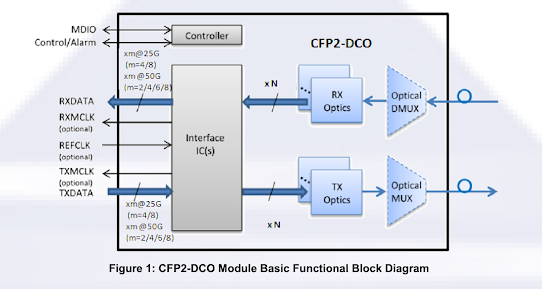The QSFP-DD Form Factor
QSFP-DD is a new module and cage/connector system similar to current QSFP, but with an additional row of contacts providing for an eight lane electrical interface. It is being developed by the QSFP-DD MSA as a key part of the industry’s effort to enable high-speed solutions.
For QSFP-DD (Double Density) designers have made two key changes to the module, while maintaining the key features that enabled the rapid acceptance of QSFP+ and QSFP28.
-
The first is to increase the number of I/O lanes of the module from 4 to 8.
-
The second is to double the data rate of each lane to 50Gb/s effectively quadrupling the overall
bandwidth of the module compared to QSFP28. The IEEE made the choice to standardize on PAM4 signaling (designated as CEI-56G-VSR-PAM4 ) as opposed to NRZ for the ASIC to Module interface and the QSFP-DD MSA has followed the recommendation.
The QSFP-DD module form factor is the industry’s smallest 400GbE module providing the highest port bandwidth density. This form factor leverages the industry’s manufacturing capability and cost structure that supports QSFP+ and QSFP28, the industry’s de facto standards for 40GbE and 100GbE. QSFP-DD can support 36 ports of 400GbE in a single Rack Unit (RU) providing over 14Tb/s of bandwidth.
The QSFP-DD will support:
-
3m of passive copper cables
-
100m over parallel multimode fiber
-
500m over parallel single mode fiber
-
2 km and 10km over duplex single mode fiber
-
Backward compatible with all QSFP based transceivers from 40G to 200G
QSFPDD Backward compatibility feature of QSFP+ and QSFP28 enabled networks to migrate quickly to the next generation
The importance of backward compatibility has been proven in multiple generations of pluggable optics. The benefit of backward compatibility is not only to accelerate adoption of the new module type but to accelerate overall network migration by providing a convenient bridge between existing infrastructure and the next generation. This was evident in the successful migration from SFP+ to QSFP+ as described above using breakouts.
For QSFP28 ports, the backward compatibility is enabled by the ASIC. Typically, QSFP28 ports on Ethernet switches and routers can also be configured for 100GbE or 40GbE for QSFP+ modules. Customers can deploy the latest equipment with the latest feature set and continue to use modules they have already invested in where necessary, along with some of the existing infrastructure at 40GbE until they are ready to transition the rest of their network to 100GbE ports. This has accelerated the deployment of QSFP28 equipment. Table 1 shows the evolution of the QSFP form factors I/O and form factor width.
Source of above information:
http://www.qsfp-dd.com/



Comments
Post a Comment